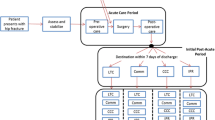Abstract
Background and aims: Hip fractures are a major cause of morbidity and mortality in the older adult population. The evidence of the incidence of morbidity and mortality in Mexican Americans compared to other ethnic groups is mixed. This study aims to examine characteristics and utilization patterns of older Mexican Americans compared to Whites and Blacks, hospitalized for hip fracture in the Southwestern United States. Methods: Retrospective analysis of the Medicare and Medicaid claims data for the southwestern states of California, Arizona, Colorado, New Mexico and Texas. All Medicare beneficiaries aged 65 and above, hospitalized for non-pathologic hip fractures, participated in the study. Mexican Americans were directly identified from the H-EPESE database. The primary outcome measures were length of stay, total charges and number of diagnoses. Results: The total proportion of hospital encounters related to hip fractures within each ethnic group was 3.7% for Whites, 2.0% for Mexican Americans and 1.2% for Blacks. The mean patient age for the hip fracture was 82.5 years while the non-hip fractures encounters had a mean age of 76.6 years. A higher percentage of Mexican Americans who suffered fracture were female. Although length of stay for Mexican Americans was equivalent to Whites, comparative total charges for Mexican Americans were lower. Mexican Americans also have lower mean number of diagnoses at admission than the other groups (MA=5.5, B=6.2, W=5.9: p<0.001). Conclusions: Mexican American elders in the southwestern United States who are hospitalized for hip fractures are more likely to be female, relatively healthier, and have lower health care costs when compared to Whites and especially to Blacks in the same region.
Similar content being viewed by others
References
Popovic JR. 1999 National Hospital Discharge Survey: annual summary with detailed diagnosis and procedure data. Vital Health Stat 2001; 13: i–v, 1–206.
Cooper C, Campion G, Melton LJ. Hip fractures in the elderly: a world-wide projection. Osteoporos Int 1992; 2: 285–9.
Brainsky A, Glick H, Lydick E, et al. The economic cost of hip fractures in community-dwelling older adults: a prospective study. J Am Geriatr Soc 1997; 45: 281–5.
Autier P, Haentjens P, Bentin J, et al. Costs induced by hip fractures: a prospective controlled study in Belgium. Belgian Hip Fracture Study Group. Osteoporos Int 2000; 11: 373–80.
De Laet CEDH, Van Hout BA, Burger H, et al. Incremental cost of medical care after hip fracture and first vertebral fracture: the Rotterdam Study. Osteoporos Int 1999; 10: 66–72.
Wiktorowicz ME, Goeree R, Papaioannou A, et al. Economic implications of hip fracture: health service use, institutional care and cost in Canada. Osteoporos Int 2001; 12: 271–8.
Haentjens P, Autier P, Barette M, et al. Hip Fracture Study Group. The economic cost of hip fractures among elderly women: a one-year, prospective, observational cohort study with matched-pair analysis. J Bone Joint Surg Am 2001; 83: 493–500.
Silverman SL, Madison RE. Decreased incidence of hip fracture in Hispanics, Asians, and Blacks: California Hospital Discharge Data. Am J Public Health 1988; 78: 1482–3.
Ross PD, Huang C. Hip Fracture incidence among Caucasians in Hawaii is similar to Japanese: a population based study. Aging Clin Exp Res 2000; 12: 356–9.
Barrett-Connor E, Siris ES, Wehren LE, et al. Osteoporosis and fracture risk in women of different ethnic groups. J Bone Miner Res 2005; 20: 185–94.
Farmer ME, White LR, Brody JA, et al. Race and sex differences in hip fracture incidence. Am J Public Health 1984; 74: 1374–80.
Bauer RL. Ethnic differences in hip fracture: A reduced incidence in Mexican Americans. Am J Epidemiol 1988; 127: 145–9.
Zingmond DS, Melton LJ, Silverman SL. Increasing hip fracture incidence in California Hispanics: 1983 to 2000. Osteoporos Int 2004; 15: 603–10.
Chiu SP, Kelsey JL, Keegan TH, et al. Risk factors for proximal humerus fracture. Am J Epidemiol 2004; 160: 360–7.
Siris ES, Miller PD, Barrett-Connor E, et al. Identification and fracture outcomes of undiagnosed low bone mineral density in postmenopausal women: results from the National Osteoporosis Risk Assessment. JAMA 2001; 286: 2815–22.
Espino DV, Palmer RF, Miles TP, et al. Prevalence, incidence, and risk factors associated with hip fractures in community-dwelling older Mexican Americans: Results of the Hispanic EPESE study. Established Population for the Epidemiologic Study for the Elderly. J Am Geriatr Soc 2000; 48: 1252–60.
Espino DV, Lichtenstein MJ, Hazuda HP, et al. Correlates of prescription and over the Counter medication usage among older Mexican Americans: the Hispanic EPESE study. J Am Geriatr Soc 1998; 46: 1228–34.
Felsenberg D, Boonen S. The bone quality framework: Determinants of bone strength and their interrelationships, and implications for osteoporosis management. Clin Ther 2005; 27: 1–11.
Ruben Craig D. Emerging concepts in osteoporosis and bone strength. Curr Med Res Opin 2005; 7: 1049–58.
Villa ML, Marcus R, Ramirez Delay R, et al. Factors contributing to skeletal health of postmenopausal Mexican-American women. J Bone Miner Res 1995; 10: 1233–42.
Shwartz M, Iezzoni LI, Ash AS, et al. Do severity measures explain differences in length of hospital stay: the case of hip fracture. Health Serv Res 1996; 31: 365–85.
Ishizaki T, Imanaka Y, Oh E, et al. Association of hospital resource use with comorbidity status and patient age among hip fracture patients in Japan. Health Policy 2004; 69: 179–87.
Markides KS. Eschbach K. Aging, migration, and mortality: current status of research on the Hispanic paradox. J Gerontol B Psychol Sci Soc Sci 2005; 60: 68–75.
Espino DV, Oakes SL. Access issues in the care of Mexican origin elders. In: The Health of Aging Hispanics: The Mexican Origin Population. New York, NY: Springer, 2007: 195–201.
Khasraghi FA, Lee EJ, Christmas C, et al. The economic impact of medical complications in geriatric patients with hip fracture. Orthopedics 2003; 26: 49–53.
Author information
Authors and Affiliations
Corresponding author
Rights and permissions
About this article
Cite this article
Espino, D.V., Ross, J.S., Oakes, S.L. et al. Characteristics of hip fractures among hospitalized elder Mexican American Black and White Medicare beneficiaries in the Southwestern United States. Aging Clin Exp Res 20, 344–348 (2008). https://doi.org/10.1007/BF03324866
Received:
Accepted:
Published:
Issue Date:
DOI: https://doi.org/10.1007/BF03324866




